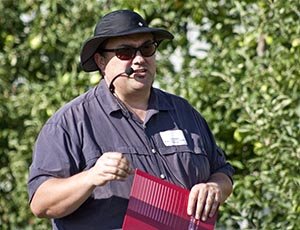
Tory Schmidt speaks about shade netting during the Washington State University field day and workshop at Sunrise Research Orchard and labs south of Wenatchee, Washington, on August 7, 2013. Schmidt is a research associate for the Washington Tree Fruit Research Commission.
TJ MULLINAX
That’s one of the questions scientists in Washington State hope will be answered by a study of the impact of various blossom-thinning methods.
During Washington State University’s annual field day at the Sunrise Research Orchard near Wenatchee this week, growers saw a trial set up three seasons ago in a Granny Smith block on Malling 9 rootstocks.
Tory Schmidt, research associate with the Washington Tree Fruit Research Commission, said the trial grew out of a national project funded by the Specialty Crop Research Initiative focusing on alternative thinning methods. These methods include the Bonner and Darwin mechanical thinning machines from Germany and handheld mechanical devices developed in Europe and at WSU. The mechanical thinners have rotating spindles with strings that physically knock buds or blooms off the trees.
The trial at WSU is a long-term study to see what happens to overall yield as a result of three different treatments: chemical thinning, mechanical thinning, and an alternation from year to year of chemical and mechanical thinning (beginning with mechanical in the first year of the trial).
The chemical thinning treatment is the industry standard program of two applications of fish oil and lime sulfur during bloom followed by one application of a postboom thinner.
“We know we get good thinning with the Darwin, but if you continue to beat up the canopy and knock off the spurs every year, does that have a long-term detrimental effect on the bearing surface?” Schmidt asked.
In the mechanically thinned trees, bloom density has decreased from 9.2 flower clusters per square centimeter of trunk cross-sectional area the first year to 6.0 clusters the second year, and only 2.7 this spring.
In comparison, bloom density in the chemical treatment went from 8.9 clusters the first year, to 2.5 the second year, but up to 3.9 clusters this year. In the alternating treatment, the flower clusters went from 6.3 to 4.1 to 4.0.
“In the mechanized thinning treatment, we’re concerned that the bloom density has gone down every year and are hoping next year it will bounce back again,” Schmidt said. “If not, it might indicate we will sacrifice long-term yield.”
Netting
Schmidt also described a trial testing the ability of two types of shade cloths to reduce sunburn in Granny Smith apples. One is an experimental netting from Extenday that covers several rows of trees in an attempt to reduce the temperature and the amount of damaging ultraviolet light that reaches the fruit surface. It was installed after bloom. Scientists will track fruit yield, size, and quality inside the netted “pod” and compare the results with fruit from uncovered trees.
Schmidt said they are also interested in any potential benefits from reducing wind stress on the trees.
“The hypothesis is if we can reduce light and wind stress on the trees, the trees will be happier and able to dedicate more of their nutrients and carbohydrates to the production of fruit,” he said.
In addition, there might be benefits in terms of protection from hail, birds, and insects.
Extenday is still refining the netting. The company is looking for ways to reduce the cost to make it more economically feasible for growers. It is also working on maximizing the amount of photosynthetically active radiation (PAR) that reaches the tree while at the same time reducing the damaging UV-B radiation that sunburns the fruit.
Asked if humidity is being monitored within the pod, Schmidt said the scientists hope to install instruments to record humidity and light intensity beneath the cover.
The other netting in the study is draped over the tree rows and is less expensive as posts are not needed to support the cover. It is designed to reduce light stress but might also reduce wind stress, Schmidt said. Sunburn and yield data will also be collected from that block.
Asked about spray penetration in covered trees, Schmidt said tests have shown that spray coverage is similar to that in uncovered blocks.

Leave A Comment